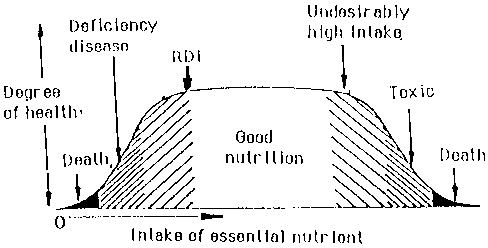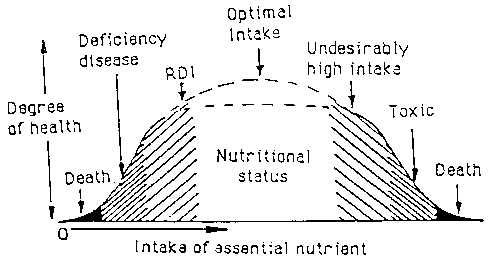Asia Pacific J Clin Nutr (1993) 2 , Suppl 1, 1-3

Introduction
A.S.
Truswell MD, FRCP
Human Nutrition Unit, Biochemistry
Department, University of Sydney, Australia.
The Nutrition Research Foundation of the University
of Sydney and ILSI Australia combined to have this special international
symposium at the time of the annual symposium of the Foundation. The
last time that the Nutrition Research Foundation and ILSI Australia
combined to put on a symposium, it eventually developed into the International
Conference on Dietary Guidelines held on the Algarve, Portugal in
1986, and published as a large supplement of the American Journal
of Clinical Nutrition1. Lists of previous symposia
held by the Nutrition Research Foundation and by ILSI Australia appear
on pages 53 and 54 of this Supplement.
The Nutrition Research Foundation is an organization
which supports the work of the Human Nutrition Unit in the University
of Sydney. ILSI Australia is an off-shoot of International Life Sciences
Institute USA, which incorporates the former Nutrition Foundation
(USA).
The first point I have to make, mainly for the journalists,
is that the ideas in this symposium represent a gradual accumulation
of information rather than a breakthrough. These ideas, the
scientific experiments, the epidemiological observations that
are reported in this Supplement, have been emerging over the last
25 years. Linus Pauling2 wrote this 23 years ago:
Unsaturated fatty substances play an important part
in the functioning of our biochemical machinery and in cell membranes
and other tissues. These substances are converted by oxidation into
peroxides that are harmful. Vitamin C and vitamin E are natural antioxidants.
An increased intake of these vitamins provide protection against cardiovascular
disease. Vitamin E may be the more important of these two natural
antioxidants, but vitamin C is also important. A proper intake of
vitamin C and vitamin E may help to prevent premature aging, especially
if one's diet is rich in polyunsaturated fats.
Some of us in a committee of the Australian National
Health and Medical Research Council worked over eight years to develop
the present set of recommended dietary intakes (RDIs) for Australians3,4.
The RDIs in Australia, although they were worked out independently,
are mostly very close in numbers to the better-known RDAs in the United
States. The definition we used was that the RDI is the amount of a
nutrient judged to be adequate to meet the known nutritional needs
of practically all healthy people and the orthodox concept is that
above the RDI there is no further health benefit to be gained (Figure
1). If you go far above it you can start, with some nutrients, to
get into trouble from undesirable effects, but for other nutrients,
the range between adequate and toxic is very large.
Figure 1. Plateau top diagram to illustrate
the intended classical position of the RDI (recommended dietary intake)
for an essential nutrient. Note: there is no further improvement in
health beyond the RDI.

The concept discussed in this symposium is that perhaps
this is not quite right. Perhaps for some nutrients there is an intake
above the RDI (ie the amount that prevents deficiency disease or subclinical
deficiencies) where the state of health is further enhanced, eg by
partial protection against the degenerative diseases of old age. This
higher intake level can be called the optimal intake (range) for a
nutrient. To express this visually, the graph of health against intake
for some nutrients would be thought of not as a plateau between the
RDI and the start of undesirable effects, but still curving upwards
for some way above the RDI level (Figure 2). Now it is relevant that
the British committee which revised their equivalent of the RDAs has
renamed these Dietary Reference Values5. These classical
numbers- RDAs, RDIs and now Dietary Reference Values have, I believe,
their main value as references (like anthropometric references) to
give an idea of the relative size of requirement of nutrients6,
because of some nutrients we require about 1 m g (vitamin B-12), of others 100mg (iodine), of others 1mg (thiamin),
and of others we require much larger, about 1 gram (calcium) and of
others 50g (protein) or 100g (carbohydrates).
In our work for the Australian Recommended Dietary
Intakes we considered in the background papers the possibility that
intakes about the amount that prevents deficiency could have beneficial
effects for each of the four vitamins considered in this symposium:
F (folate), A (or carotene), C (ascorbate) and E (tocopherols).
Figure 2. The alternative concept. Ingestion
of the RDI should guarantee no deficiency disease but beyond the RDI
there may still be additional health benefits (eg partial protection
from a degenerative disease). The top of the dome beyond the RDI is
then the optimal intake range.

On folate (1984)7 'an important and much-discussed
question is whether folate deficiency in early pregnancy predisposes
to foetal malformations, particularly harelip and neural tube defects'.
The evidence, before the MRC trial was suggestive but incomplete.
Our background paper on vitamin A (1986)8
had four paragraphs on possible protective effects against cancer.
'Although there is considerable epidemiological and laboratory evidence
to suggest that retinoids have a role in the prevention of cancer
it is not yet clear which compounds are responsible for this effect.
Ziegler et al. have recently reviewed several studies of diet and
lung cancer and have found that inverse associations have been noted
more frequently (in six out of seven studies) with indices of carotene
intake or carotene containing foods. Again the evidence was incomplete
and confusing, eg with some negative prospective serum levels.
'For vitamin C9 there were four criteria
we considered when re-working the RDI for Australia:
- intake that prevents scurvy,
- intake to give tissue saturation,
- intake that maximises absorption of non-haem iron,
- intake that may minimise risk of gastric cancer.'
After careful consideration the committee decided
on an intake to prevent scurvy in smokers and give 'reasonable' reserve
in most people but not saturation. 'We thought the data about a protective
effect of vitamin C against gastric cancer are not [in 1987] sufficiently
quantitative for working out an RDI; it should be covered by the dietary
guideline 'eat more vegetables and fruit'.
The background paper on vitamin E10 noted
some reports of a therapeutic value of vitamin E for intermittent
claudication and preliminary evidence suggesting possible protective
effects against cancer of the stomach and of the breast. Clearly further
research is needed in this important area.
The committee concluded at the end of the 1980s9
The optimum nutrition position sees a peak
of physiological function rather than a plateau between deficient
and toxic intakes and wants to include more recent hypotheses about
the role of generous intake of several nutrients in prevention of
cancer, etc. This is something we all have to do at the practical
level but in the present state of our knowledge we cannot use non-quantitative
epidemiological evidence of a protective effect of (say) vegetables
and fruits against certain cancers to change the RDI for vitamin
C. This new tentative, provisional epidemiological information is
suitable material to go into dietary guidelines, not the sort of
continuous quantitative data that go to make up RDIs'.
In the last paragraph of 1990 editorial for the British
Medical Journal, entitled 'Who should take vitamin supplements?'11,
having listed the sort of people (minorities) who would benefit from
the right vitamin supplements, I noted that work was going on which
might change the opinion that the majority of healthy people do not
need vitamin supplements. We were waiting in 1990 for the results
of the Medical Research Council's Trial on Prevention of Neural Tube
Defects12 and we needed to watch work going on about antioxidant
vitamins.
The ideas for this Symposium come from the USA from
the New York Academy of Science meeting in February 1992 called 'Beyond
deficiency' 13, which was very well summarized for the
lay person in Time magazine14. They come from the
2nd International Symposium on Nutrition and Fitness in Athens in
May 1992, which some of us attended, they come from work funded by
the Ministry of Agriculture, Fisheries and Food in Britain and there
is also an initiative near Sydney which I shall present.
Many people contributed to the organization of this
symposium: Professor Ron Edwards, Dr Efi Farmakalidis, Mr Steve Kirkham
for ILSI and Dr Chris Hudson who is on the Board of ILSI chaired the
afternoon session. At the University of Sydney: Isa Hopwood, Zia Ahmad
(who tape-recorded the talks), Peter Williams should be specially
thanked, but the heaviest load of the administration was carried by
Marianne Sylvada de Soza.
The symposium was originally held
at the Stephen Roberts Lecture Theatre in the University of Sydney
on 4 December 1992. Over 200 people attended and we have had many
requests for a published version, which follows.
References
- Diet and Health: Scientific concepts and principles.
Proceedings of a symposium held in Alvor, Algane, Portugal, 19 -
22 October 1986. Amer J Clin Nutr 1987; 45:1015 -1414.
- Pauling L. Vitamin C, the Common Cold and the Flu.
p191. San Francisco: WK Freeman, 1970.
- Truswell AS, Dreosti IE, English RM, Rutishauser
IHE and Palmer N. Recommended Nutrient Intakes. Australian Papers.
Mosman, NSW: Australian Professional Publications, 1990.
- Truswell AS, Coles-Rutishauser IHE, Dreosti IE,
English RM et al. National Health and Medical Research Council.
Recommended Dietary Intakes for Use in Australia, Canberra: Australian
Government Publishing Service, 1991.
- Department of Health. Report of the Panel on Dietary
Reference Values of the Committee on Medical Aspects of Food Policy.
Dietary Reference Values for Food Energy and Nutrients for the United
Kingdom. Report on Health and Social Subjects. 41. London: HM Stationery
Office, 1991.
- Truswell AS. The philosophy behind recommended
1 dietary intakes: can they be harmonized? Eur J Clin Nutrition,
44 (Suppl 2):3-11.
- Truswell AS. Folate. In: Truswell AS, Dreosti IE,
English RM, Rutishauswer IHE and Palmer N, eds. Recommended Nutrient
Intakes: Australian Papers, 1990: 96- 11 109. Australian Professional
Publications: Mosman, NSW.
- Rutishauser IHE. Vitamin A. In: Truswell AS, Dreosti
IE, English RM, Rutishauser IHE, Palmer N, eds. Recommended Nutrient
Intakes: Australian Papers, 1990: 1: 36-50. Australian Professional
Publications: Mosman, NSW.
- Truswell AS. Recommended nutrient intakes: some
general principles and problems. In: Truswell AS, Dreosti IE, English
RM, Rutishauser IHE, Palmer N, eds. Recommended Nutrient Intakes:
Australian Papers, 1990: 18-24. Australian Professional Publications:
Mosman, NSW.
- Roberts DCK. Vitamin E. In: Truswell AS, Dreosti
IE, English RM, Rutishauser IHE, Palmer N, eds. Recommended Nutrient
Intakes: Australian Papers, 1990: 159175. Australian Professional
Publications: Mosman, NSW.
- Truswell AS. Who should take vitamin supplements?
BMJ, 1990;301:135-136.
- MRC Vitamin Study Research Group. Prevention of
neural tube defects: results of the Medical Research Council Vitamin
Study. Lancet 1991;338:131-137.
- New York Academy of Sciences, February 9-12 1992.
Beyond Deficiency: new views on the function and health effects
of vitamins. Annals of the New York Academy of Sciences 669.
- Horowitz JM, Lafferty E and Thompson D. The new
scoop on vitamins. Time (Australia). 6 April 1992, pp50-55.

Copyright © 1993 [Asia Pacific Journal of Clinical
Nutrition]. All rights reserved.
to the top